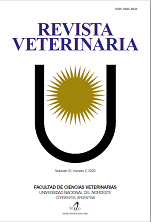Feline leishmaniasis (L. infantum) in Paraguay. Diagnose, treatment and evolution
DOI:
https://doi.org/10.30972/vet.3124745Keywords:
cat, Leishmania infantum, allopurinol, domperidone, sulfadimethoxineAbstract
Leishmaniasis is a group of zoonotic diseases caused by a protozoa of the genus Leishmania sp. There have been numerous cases in canines, and in recent years isolated cases in felines were reported. Therefore, cats that live in endemic areas of leishmaniasis are significantly more likely to be infected. It is probable that feline’s immune system is able to control the infection of the parasite, either by eliminating it or by keeping it in a chronic subclinical state. We report a feline case, young adult from Asuncion (Paraguay) with non-specific clinical symptoms. Complementary hematological studies were performed, among them peripheral blood smear and bone marrow puncture, that allowed the identification of the presence of amastigotes of Leishmania sp. L. infantum was identified by molecular techniques. Patient was submitted to treatment, with favorable response and total remission of clinical signs. The identification of the protozoa is determinant for the diagnosis of this disease. Therefore, feline leishmaniasis is less frequent, but not non-existent, and should be included as a differential diagnosis, especially in endemic areas.Downloads
References
Ayllon T et al. 2008. Serologic and molecular evaluation of Leishmania infantum in cats from Central Spain. Ann N Y Acad Sci 1149: 361-364.
Beverley SM. 2003. Protozomics: trypanosomatid parasite genetics comes of age. Nat Rev Genet 4: 11-19.
Bongiorno G, Habluetzel A, Khoury C, Maroli M. 2003. Host preferences of phlebotomine sand flies at a hypoendemic focus of canine leishmaniasis in central Italy. Acta Trop 88: 109-116.
Martin MJ et al. 2007. Infection by Leishmania infantum in cats: epidemiological study in Spain. Vet Parasitol 145: 267-273.
Sergent E, Sergent E, Lombard J, Quilichini M. 1912. La leishmaniose à Alger. Infection simultanèe d’ un enfant, d’ un chien, et d’ un chat dans la même habitation. Bull Soc Pathol Exot 5: 93-98.
Simoes ML et al. 2005. The susceptibility of domestic cats (Felis catus) to experimental infection with Leishmania braziliensis. Vet Parasitol 127: 199-208.
Solano G et al. 2007. Cross-sectional serosurvey of feline leishmaniasis in ecoregions around the Northwestern Mediterranean. Am J Trop Med Hyg 76: 676-678.
Downloads
Published
How to Cite
Issue
Section
License
Revista Veterinaria (Rev. Vet.) maintains a commitment to the policies of Open Access to scientific information, as it considers that both scientific publications as well as research investigations funded by public resources should circulate freely without restrictions. Revista Veterinaria (Rev. Vet.) ratifies the Open Access model in which scientific publications are made freely available at no cost online.











.jpg)
.jpg)



